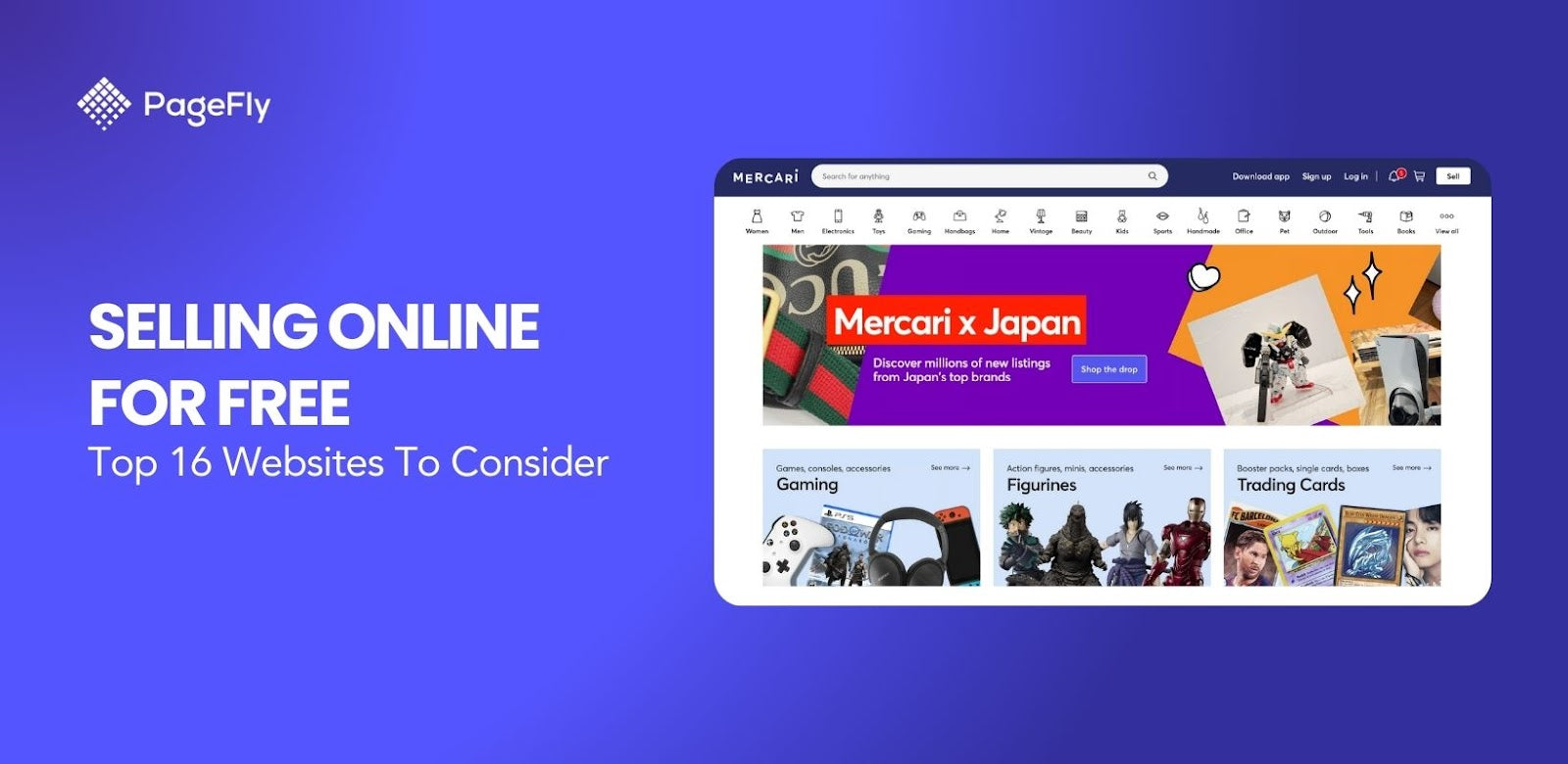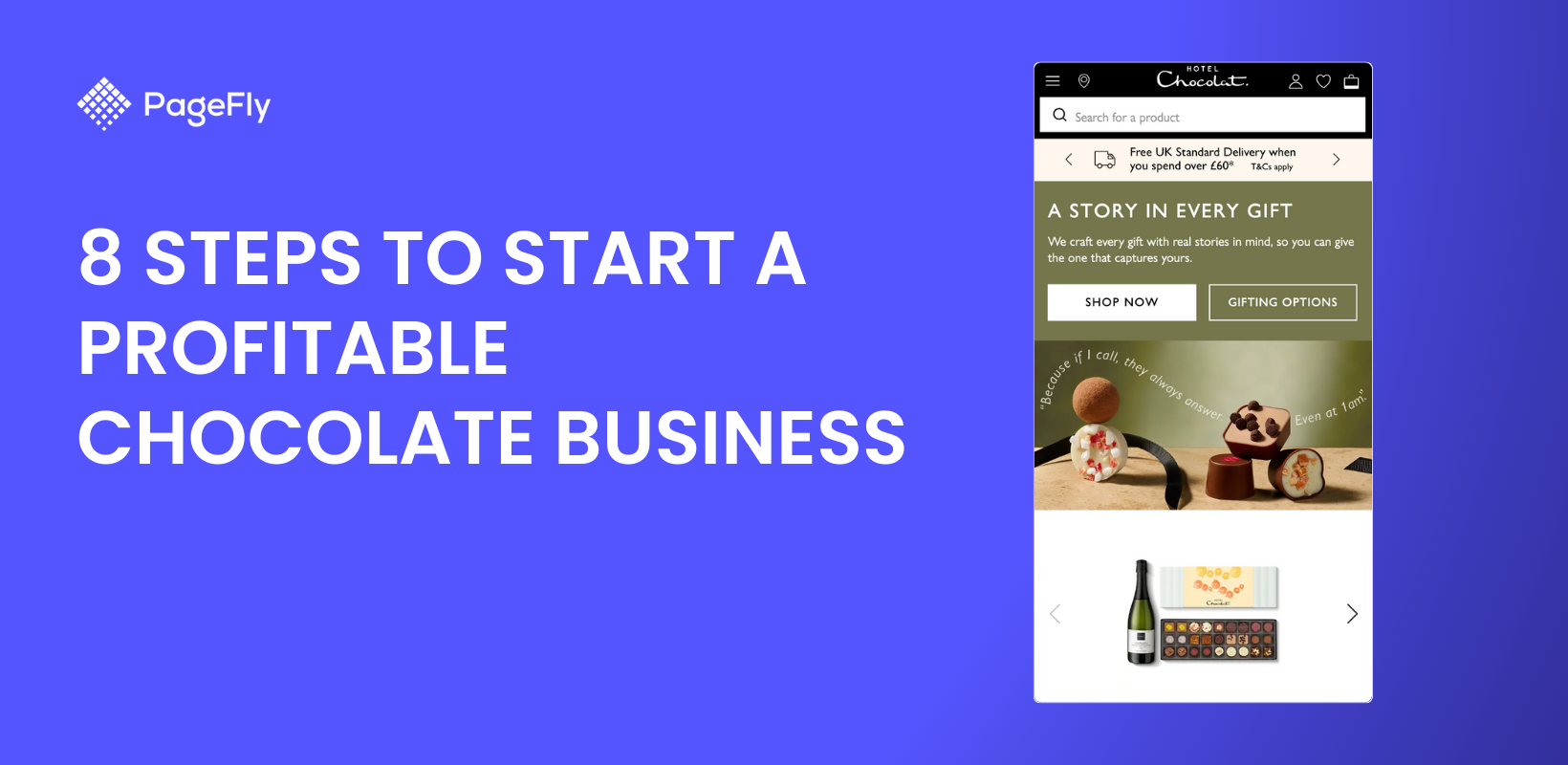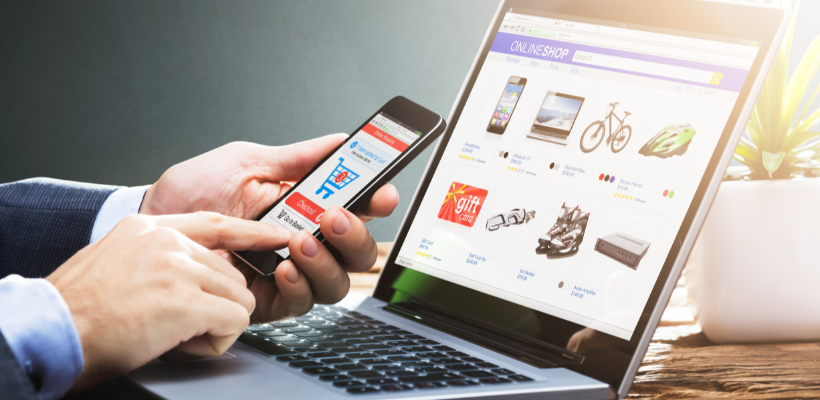Looking for the best websites to sell items online for free? This comprehensive guide reveals 16 proven platforms where you can sell online for free without any upfront costs. Whether you're wondering what is the best way to sell online or need specific free selling platforms, we'll show you exactly where to start earning money today. Luckily, those days are gone. Nowadays, business owners are presented with some exciting opportunities for selling online for free with their products and services.
This guide answers the question 'what is the best way to sell online' by comparing 16 websites to sell items online for free. You'll discover: 7 completely free platforms with zero fees, 9 free-to-list sites with transaction fees, step-by-step instructions for how to sell online for free, and expert recommendations for choosing the right platform based on your product type.
Whether you’re clearing out your closet or launching your first venture, you might be asking, “Where can I sell my stuff online for free?” The good news is that there are numerous free selling platforms that cater to different needs, enabling you to sell goods and services online without heavy investment.
We understand that when you're starting your journey, affordability and flexibility are key. That's why this guide will help you discover how to sell online for free with some of the top websites, offering cost-effective solutions to reach your customers without breaking the bank.
💡 Quick Answer: Can You Really Sell Online for Free?
Yes, you can sell online without upfront costs through these methods:
- Social media marketplaces (Facebook Marketplace, Instagram Shopping)
- Classified sites (Craigslist, OfferUp)
- Peer-to-peer platforms (Depop, Vinted, Poshmark)
However, "free" platforms have hidden costs:
- Transaction fees (5-20% per sale)
- No custom domain or branding
- Limited customer data access
- Basic or no analytics
- Platform dependency risks
For serious sellers: Platforms like Shopify offer 3 days free, then just $1/month for 3 months — often cheaper than "free" platform fees once you're making regular sales.
Alternative to Selling Online For Free
Selling online for free using the platforms we’re about to disclose in a while is a great way to test the waters in your online business. But if you want to create a long-lasting brand identity, having your own platform is the way to go.
So before we answer the question, “Where can I sell my stuff online for free?” how about we ask a better question:
How can I establish a long-term online business with the possibility of expanding into a global brand?
While free selling platforms are great for testing the waters or managing small-scale sales, aspiring entrepreneurs often ask, "how much money do you need to start a business?" Fortunately, free platforms minimize upfront costs, but for those aiming for long-term sustainability, limitations like restricted branding opportunities, lack of control over customer data, and constrained scalability become significant factors to consider.
These platforms often come with limitations that can cost you more than a paid platform:
📊 Free vs Paid Platforms: The Real Cost Comparison
| Feature | Free Platforms | Shopify |
|---|---|---|
| Upfront Cost | $0 | $0 (3-day trial), then $1/mo for 3 months |
| Transaction Fees | 5-20% per sale | 2.9% + 30¢ (credit card only) |
| Monthly Cost Example (selling $1,000/month) | $50-200 in fees | $29 + ~$32 processing = $61 total |
| Custom Domain | ❌ No (yourstore.platform.com) | ✅ Yes (yourstore.com) |
| Customer Email List | ❌ Platform owns it | ✅ You own it |
| Design Customization | ❌ Limited templates | ✅ Full control |
| SEO & Analytics | ❌ Basic or none | ✅ Professional tools |
| Inventory Management | ❌ Manual tracking | ✅ Automated system |
| Mobile Optimization | ⚠️ Varies by platform | ✅ Mobile-first design |
| Scaling Potential | ❌ Platform limits | ✅ Unlimited growth |
| Support | ❌ Community forums | ✅ 24/7 expert support |
💰 Reality Check: If you're selling just $500/month, "free" platform fees (avg. 10% = $50) already exceed Shopify's basic plan ($29). Plus, you lose customer data, branding, and growth potential.
As your business grows, you’ll want a platform that is truly yours, offering the tools and flexibility to evolve into a global brand.
Enter Shopify: a trusted solution chosen by millions of merchants worldwide.

Price: Starts at $39 per month. Free trial available.
Why Shopify Is A Trusted Option
Shopify stands out for its reliability, scalability, and ease of use. It’s more than just a selling platform – it’s an all-in-one solution that helps you build, customize, and manage your own online store.
Shopify has the following advantages over free online marketplaces to sell:
- Customizable Online Storefronts
- Scalability
- Global Reach
- Robust App Ecosystem
- Security and Support
So, if you’re ready to take your business to the next level and lay the foundation for a global brand, why wait? Start your journey with Shopify today!
Top Websites To Sell Items Online For Free
Now that you know the importance of branding using Shopify, let’s talk about the platforms that you can use for free.
There are to two types of free online marketplaces to sell your stuff in:
- Completely free websites
- Websites that don’t require upfront fees but charge sales fees
We’ll tackle all these in this article. But to start off our discussion, let’s first begin with websites where you don’t need to spend money at all.
Here are seven (7) websites to sell items online for free:
Facebook Marketplace

Best For: Sellers targeting local buyers who want to connect with a broader audience using a familiar platform.
Apart from connecting people with one another, Facebook has revolutionized how we buy and sell products. It’s now one of the most accessible platforms to sell online for free.
With its local-first approach, Facebook Marketplace is ideal for selling furniture, electronics, household items, or even services to nearby buyers. The platform integrates seamlessly with your Facebook account, making it easy to list items for free and reach a broad audience.
Key Benefits
- No Listing Fees
- Integration with Your Facebook Account
- Local-First Approach
- Direct Negotiation via Messenger
- Wider Reach
Pros
- Listing items is as simple as posting on your Facebook feed.
- You can sell items both in groups and on the Marketplace for increased exposure.
- Buyers can search for specific items or browse nearby listings using the search bar.
Cons
- Facebook does not verify products, buyers, or sellers, which could lead to scams.
- No built-in shipping facility is available.
- If sellers use the Marketplace Checkout option, a 5% fee is charged for items over $8 or $0.40 for items under $8. However, people can always transact in-person to avoid fees.
DeCluttr

Best For: Tech-savvy individuals decluttering their homes and looking for a reliable way to recycle and sell their gadgets and media.
Decluttr is another fantastic platform to start selling online for free, particularly for those looking to trade in old tech or other media items.
Not only does Decluttr provide you an opportunity to earn money, but it also contributes to an eco-friendly practice by encouraging the reuse of gadgets and media.
It’s ideal for selling tech gadgets, CDs, DVDs, and even Blu-Rays, offering a seamless selling experience with instant valuations and hassle-free shipping.
Key Benefits
- Free Shipping Labels
- Guaranteed Next-Day PaymentPrice Guarantee for 28 Days
- Trouble-Free Selling Process
Pros
- Sellers receive an instant and free quote for the products they wish to sell.
- Decluttr takes care of shipping, ensuring the selling experience is smooth and economical.
- Payments are processed quickly after product inspection, eliminating waiting times.
Cons
- Certain items like CD singles, EPs, VHS tapes, vinyl, and cassettes cannot be sold on Decluttr.
- Media items require a minimum of 10 units to sell.
- A minimum order value of $5 is required to complete a transaction.
Craigslist

Best For: Sellers comfortable with direct buyer interactions who want a simple platform to sell online.
Craigslist remains a reliable choice for individuals seeking to sell online for free without platform-imposed complications.
Its long-standing presence, simple interface, and wide reach ensure that sellers can connect with local buyers effectively, making it an ideal platform for those who value ease and direct interaction.
Key Benefits
- No Fees or Commissions
- Broad Audience Reach
- Simple and Flexible
Pros
- A cost-free platform for listing a wide range of items.
- Offers the flexibility to sell locally without worrying about shipping logistics.
- Popular for selling bulky items like furniture or large appliances that are better suited for local transactions.
- Straightforward interface that doesn’t require tech-savvy skills.
Cons
- No verification process for buyers or sellers, which can lead to potential scams.
- Limited tools for managing listings or promoting items compared to modern marketplaces.
- Relies on direct communication, which may not appeal to all sellers.
- No in-app payment system, requiring buyers and sellers to agree on payment methods independently.
Is Craigslist Free to Sell? Complete Guide
Yes, Craigslist is completely free to sell on for most categories. Unlike other platforms that charge transaction fees, Craigslist allows you to list and sell items with zero costs. How to sell on Craigslist effectively: Choose the right category, write detailed descriptions, include multiple photos, and respond quickly to inquiries.

Oodle

Best For: Sellers looking for a user-friendly platform with social media elements.
Oodle is a classified-style online marketplace that integrates social networking for a more personalized buying and selling experience.
It combines the simplicity of traditional classified ads with the interactivity of social media, making it an excellent option for sellers who want to sell online for free while leveraging the trust and reach of their social networks.
Its localized focus and personalized approach ensure a seamless experience for both buyers and sellers.
Key Benefits
- Free Listings
- Integration with Social Networks
- Localized Listings
Pros
- A platform that blends classifieds with social media, enhancing buyer and seller interactions.
- Free to use, with no listing fees or commissions.
- Ideal for sellers looking to build trust and visibility by utilizing their social connections.
- Simplifies local selling by highlighting items based on proximity.
Cons
- Relatively smaller user base compared to larger marketplaces like Craigslist or Facebook Marketplace.
- Limited tools for promoting listings beyond your social network.
- Relies heavily on the seller's social connections, which may not suit everyone.
- No integrated payment system, requiring independent arrangements between buyers and sellers.
Varage Sale

Best For: Local sellers prioritizing safety and seeking free selling platforms for community-based transactions.
VarageSale is a standout option for sellers looking for a safe and community-oriented way to sell items online.
Unlike other marketplaces, this platform ensures secure transactions by verifying all users before they can buy or sell.
This extra layer of security fosters trust within local communities, making it ideal for those who want peace of mind while connecting with nearby buyers.
Key Benefits
- Secure, Verified User Profiles
- Community-Based Focus
- Free to Use
Pros
- Provides a secure environment for local transactions with its user verification system.
- A simple interface that is easy to navigate for both sellers and buyers.
- Encourages community interaction, which fosters trust and repeat sales.
- Completely free to list items, keeping costs low for sellers.
Cons
- Limited to local communities, so it may not be ideal for those targeting a broader audience.
- User base is smaller compared to larger marketplaces like Facebook Marketplace or Craigslist.
- Does not offer advanced tools for marketing or promoting listings.
eCrater

Best For: Sellers wanting an online store without the overhead, making it one of the most versatile free selling platforms.
eCrater is a unique online marketplace that combines the convenience of a free selling platform with the flexibility of a customizable online storefront.
With no fees for basic usage, eCrater provides sellers with the ability to list products in a wide range of categories while also offering the option to create a dedicated online store.
Key Benefits
- Free Store Setup
- Wide Range of Categories
- Dual Selling Options
Pros
- No fees for listing products or setting up a store.
- Offers customization options, enabling sellers to build a distinct brand identity.
- Provides a dual approach: sell within the marketplace or through a standalone online store.
- Supports a broad range of product categories, making it suitable for various niches.
Cons
- Limited marketplace traffic compared to major platforms like Amazon or eBay.
- Customization options, while available, may not be as robust as paid platforms.
- Requires more effort from sellers to drive traffic to their standalone storefronts.
NextDoor

Best For: Sellers looking to engage with a local, trusted audience who value community-driven recommendations.
Nextdoor is not just a community hub but also one of the best websites to sell items online for free, particularly for local transactions.
Whether you’re a small business owner, a neighbor decluttering, or an organization offering public services, Nextdoor provides an excellent platform to connect with a niche, trusted audience.
For those asking, “Where can I sell my stuff online for free locally?” Nextdoor offers a simple and trustworthy solution. The platform is designed to foster connections between people living in the same area, making it ideal for promoting local businesses or products to a niche audience.
Key Benefits
- Completely Free
- Trustworthy Recommendations
- Business-Specific Pages
- Localized Marketing with Ads
- Niche Targeting
Pros
- Free to use for both individuals and businesses.
- Access to a trusted audience, fostering higher sales conversions.
- Ability to create business-specific pages for enhanced engagement.
- Local ad features to expand reach and visibility within the community.
Cons
- Limited to local communities, making it unsuitable for global sales.
- Sellers can only target users within the specified area of the platform.
Websites to Sell Items Online for Free Locally
For websites to sell items online for free locally, these platforms excel at connecting you with nearby buyers: Facebook Marketplace dominates local sales with location-based search features. Craigslist remains the go-to for furniture and large items that require pickup. VarageSale offers verified local communities for safe transactions. OfferUp combines local meetups with optional shipping nationwide.

🚀 From Free to Professional: When to Upgrade Your Selling Strategy
Starting with free platforms is smart — but knowing when to level up is even smarter. Here's your growth roadmap:
Stage 1: Testing the Waters (Month 1-3)
You're Here If: Just starting, decluttering, or validating a product idea
Best Platforms: Facebook Marketplace, Craigslist, OfferUp
Monthly Revenue: $0-500
Focus: Learning what sells, understanding customer needs
💡 Pro Tip: Track every sale in a spreadsheet — you'll need this data later
Stage 2: Consistent Side Hustle (Month 3-6)
You're Here If: Making 5-10 sales monthly, seeing repeat customers
Best Platforms: Mercari, Poshmark, or niche platforms for your product
Monthly Revenue: $500-1,500
Focus: Streamlining operations, building social proof
🚨 Transition Signal: When platform fees exceed $50/month, it's time to consider Shopify
Stage 3: Business Building (Month 6+)
You're Here If: Ready for your own brand, want customer emails, need analytics
Recommended Move: Start Shopify's free trial
Monthly Revenue: $1,500+
Focus: Brand building, email marketing, customer retention
💰 Smart Money Move: If you're paying more than $29/month in platform fees, you're already paying for Shopify without getting the benefits. Make the switch and get:
- Your own .com domain
- Customer email list (worth $$$)
- Professional analytics
- Unlimited growth potential
Start Your 3-Day Shopify Free Trial → Then get 3 months for just $1/month!
The Hidden Cost Calculator
Not sure if you're ready? Do this quick math:
- Your monthly sales: $______
- Multiply by platform fee rate (usually 10-20%): $______
- If line 2 is over $29, you're already paying more than Shopify costs
Example: Selling $400/month on Poshmark (20% fee) = $80 in fees vs. Shopify at $29 + payment processing (~$12) = $41 total. You'd save $39/month AND own your customer list!
Free Selling Platforms (But With Sales Or Transaction Fees)
The websites below are free online marketplaces to sell your stuff in. But there’s a caveat: even though using them is free, you need to pay a sales, transaction, or commission fee when you make a sale.
The good thing about this is that there's still no initial investment and you only spend when you sell.
Swappa

Best For: Tech enthusiasts or individuals with gently used electronics who want a hassle-free and profitable selling experience.
Swappa stands out as one of the best free selling platforms for gently used electronics, making it an excellent option for those exploring part time business ideas. Tech enthusiasts, in particular, can sell gadgets with no listing fees and minimal commissions while earning supplemental income.
Swappa’s strict policies ensure that only high-quality, fully functional products are listed, offering value to both buyers and sellers.
Key Benefits
- No Listing Fees
- Strict Quality Control
- Direct Selling
- Instant Payment
- Competitive Seller Fees
Pros
- Lower seller fees compared to platforms like eBay, enabling better profit margins.
- Easy-to-navigate interface for listing items quickly and effectively.
- Direct selling process ensures transparency and eliminates unnecessary costs.
- Sellers benefit from competitive pricing due to high demand for quality electronics.
- A trusted platform for both buyers and sellers, with strict product evaluations.
Cons
- Limited to U.S. users; products are only shipped within the United States.
- Buyers pay an additional fee for each transaction.
- Only fully functional products are eligible, meaning items with minor damage are not accepted.
ThredUp

Best For: Individuals looking for a sustainable way to resell women’s and children’s clothing while reducing fashion waste.
Perfect for selling clothes with a focus on sustainable fashion, ThredUp is an excellent platform for those who want to sell online for free while contributing to reducing fashion waste.
The platform simplifies the process with its "Clean Out" kit. Sellers simply fill the kit with items they want to sell, ship it to ThredUp, and let them handle the rest, including inspection, photography, marketing, and shipping.
Sellers receive payouts for sold items either as store credits or direct cash.
Key Benefits
- Hassle-Free Process
- No Upfront Fees
- Promotes Sustainability
Pros
- Ideal for individuals looking to earn money by selling used clothing.
- Reduces the environmental impact of fast fashion by promoting reuse and resale.
- A straightforward "Clean Out" process that eliminates the hassle of listing and shipping items.
Cons
- Only items passing the platform’s 12-point inspection are eligible for sale.
- There’s no guarantee that listed items will sell.
- Sellers only receive their earnings after the product return window closes.
- Not all brands are eligible for payouts.
OfferUp

Best For: Individuals looking for free online marketplaces to sell locally, particularly those who prefer in-person transactions and want to avoid platform commissions.
Combining free listings with optional promotions for increased visibility, OfferUp is a mobile-first free online marketplace to sell both old and new items.
Designed for local transactions, OfferUp is a user-to-user (C2C) platform that connects buyers and sellers in the same area.
With millions of active users, sellers have access to a wide range of potential buyers, making it a convenient option for in-person sales.
Key Benefits
- Free Listings
- Mobile App Convenience
- Promotions for Visibility
Pros
- Easy-to-use app for creating and managing listings.
- Facilitates direct communication between buyers and sellers through in-app messaging.
- Offers a paid promotion feature to boost visibility and increase the chances of selling items.
- Sellers can keep 100% of their profits when items are sold locally via meet-ups.
Cons
- Limited to local transactions unless you opt for shipping.
- Sellers must maintain a good rating to build trust and drive consistent sales.
- Negotiations and haggling can reduce the final selling price.
- Potential risk of encountering scam buyers.
- If the seller opts to ship items, a transaction fee is applicable.
Mercari

Best For: Sellers looking for a simple and hassle-free platform to reach a broad audience without upfront listing fees.
Mercari is a user-friendly online marketplace that allows you to list items for free, making it an accessible option for sellers of all types.
The platform charges a 10% fee on completed sales, ensuring that you only pay when your item is successfully sold.
Mercari’s wide reach and intuitive interface make it ideal for selling a variety of items, from clothing and electronics to home goods and collectibles.
Key Benefits
- Free Listings
- Wide Product Categories
- Easy-to-Use App
Pros
- Zero upfront costs for listing items, making it risk-free to start selling.
- Provides shipping assistance, including discounted rates through its platform.
- The platform’s popularity ensures a large buyer base, increasing chances of sales.
- Offers seller protection, ensuring a safe transaction process.
Cons
- A 10% fee is charged on completed sales, which might reduce profit margins.
- Focuses primarily on U.S. users, limiting international selling opportunities.
- Items must be shipped, which might not suit sellers looking for in-person transactions.
Poshmark

Best For: Fashion-focused sellers looking for free online marketplaces to sell clothing, accessories, and shoes while benefiting from a social community.
Poshmark is a leading platform tailored specifically for fashion sellers. It allows users to list items for free, with fees deducted only from final sales.
This social commerce platform stands out for its community-driven approach, enabling sellers to connect with buyers through virtual “closets.”
Whether you’re selling designer handbags, trendy apparel, or shoes, Poshmark makes it easy to reach a style-conscious audience.
Key Benefits
- Free Listings
- Fashion-Focused Marketplace
- Social Community
Pros
- No cost to list items, making it risk-free to start selling.
- The community-driven model helps boost visibility for listings through social interactions.
- Offers shipping assistance, including pre-paid labels for convenience.
- Ideal for selling both casual and luxury fashion items.
Cons
- A 20% fee is charged on sales over $15, or a flat $2.95 for items below $15, which may reduce profit margins.
- Primarily focuses on the U.S. market, limiting international selling opportunities.
- Heavy reliance on community engagement might require extra effort from sellers to promote their listings.
Vinted

Best For: Sellers looking for a platform with no upfront costs to list items, particularly for pre-loved fashion and accessories.
Vinted is a popular online marketplace that allows users to sell clothing, accessories, and home goods without any listing fees.
Instead, the platform applies buyer protection fees, ensuring secure transactions for buyers and sellers alike.
Vinted’s user-friendly interface and focus on sustainable fashion make it a favorite for individuals looking to declutter their wardrobes while earning some extra income.
Key Benefits
- No Listing Fees
- Secure Transactions
- Wide Product Range
Pros
- Zero cost to list items, allowing sellers to keep their upfront expenses minimal.
- A simple and intuitive app makes listing and managing items easy.
- Strong focus on sustainable fashion, attracting environmentally conscious buyers.
- Provides shipping assistance and tracks transactions within the app for convenience.
Cons
- Buyers are charged protection fees, which might deter some purchases.
- Sellers may face competition due to the high volume of listings.
- Primarily caters to fashion and lifestyle items, limiting options for other categories.
Chairish

Best For: Sellers specializing in furniture and decor who want access to an audience passionate about unique and high-quality pieces.
Chairish is a top-tier platform tailored specifically for selling furniture, home decor, and vintage items.
While it charges commissions on higher-priced items, it allows sellers to list for free, making it one of the premium websites to sell items online for free in the niche of home furnishings.
With a carefully curated marketplace and a focus on design-savvy buyers, Chairish is perfect for sellers looking to reach a discerning audience willing to invest in standout pieces.
Key Benefits
- Free Listings
- Specialized Niche
- Curation
Pros
- A focused marketplace for furniture and decor, attracting buyers specifically interested in high-end or unique items.
- Provides free tools to help sellers estimate prices and set competitive listings.
- Offers shipping assistance, simplifying logistics for large items.
- Features promote listings to design enthusiasts and industry professionals.
Cons
- Commission fees can be steep, particularly for higher-priced items.
- The platform’s niche focus limits its appeal for sellers outside the furniture and decor categories.
- Requires approval for listings, which may delay the selling process.
Reverb

Best For: Musicians, collectors, and sellers specializing in musical instruments and gear.
Reverb is a leading online marketplace tailored specifically for buying and selling musical instruments, audio equipment, and related gear.
Whether you’re selling guitars, keyboards, or studio equipment, Reverb provides a specialized platform with an engaged audience of music enthusiasts.
While the platform charges a 5% selling fee, its niche focus and expansive reach make it a trusted option for those in the music industry.
Key Benefits
- Specialized Niche
- Transparent Fees
- Tools and Resources
Pros
- Highly focused marketplace, ensuring listings reach an audience passionate about music.
- Provides shipping assistance and secure transaction features for peace of mind.
- Free to list items, with fees only applied after a successful sale.
- Community-driven with forums and support for musicians and sellers.
Cons
- A 5% selling fee applies to completed sales, which may impact profit margins.
- Focused solely on music gear, limiting its use for selling other types of products.
- Shipping costs can be significant for larger or fragile instruments.
Depop

Best For: Fashion-focused sellers, particularly those targeting a Gen Z audience on websites to sell items online for free.
Depop is a social shopping platform that has become a favorite among Gen Z for buying and selling trendy fashion items.
While there’s a 10% fee per sale, the platform allows free listings, making it a cost-effective option to start selling.
Depop’s user-friendly app and social media-like interface enable sellers to create visually appealing storefronts and connect with a highly engaged audience. It’s especially popular for selling pre-loved, vintage, and streetwear items.
Key Benefits
- Free Listings
- Gen Z Popularity
- Customizable Storefronts
Pros
- Strong community of buyers looking for niche and trendy fashion.
- Combines eCommerce with social media features, enhancing engagement and visibility.
- Free to list items, keeping entry barriers low for new sellers.
- Great for selling vintage, handmade, or unique clothing items.
Cons
- A 10% selling fee is deducted from every sale, which can impact profits.
- Highly competitive, requiring sellers to actively promote their listings.
- Focused solely on fashion, limiting options for sellers of other product categories.
How To Sell Online For Free
If you’re planning to launch a small-scale online selling business, asking, “Where can I sell my stuff online for free?” won’t simply cut it.
Instead, you need to find the right platform that’s available to your target audience.
Check out these quick instructions to know how to sell a product online for free:
Step 1: Choose The Right Platform
Research various platforms where you can list items for free by considering the nature of your products and your target audience. For instance, exploring business ideas for stay at home moms, such as selling handmade crafts or running a reselling store, can help identify platforms that align with specific needs and lifestyles.
Step 2: Create A Credible Profile
Sign up for an account on the chosen platform and complete your profile. A professional and trustworthy profile not only enhances credibility but also increases your chances of making sales.
Step 3: Understand The Platform’s Rules
Being aware of these details can help you avoid potential issues, such as account suspension, and ensure a smoother selling experience.
Step 4: Photograph Your Products
Images play a crucial role in attracting buyers, so make sure they highlight the product’s key features.
Once your photos are ready:
- craft a detailed and compelling product description
- include specifics such as dimensions, condition, brand, and any unique features
- be honest, especially if it’s a used item
- use relevant keywords that potential buyers might search for
A clean, well-presented product with an honest description and clear photos will significantly improve your listing’s success.
Conclusion
Selling online for free is a fantastic way to earn extra income or launch an online business without any financial risk. Starting with platforms like Facebook Marketplace or Craigslist allows you to learn the ropes and get a feel for the online selling process.
However, as your business grows and your needs expand, investing in paid platforms like Shopify can help you scale your operations, reach a wider audience, and enhance your capabilities.
Free selling platforms are a great starting point to learn how to sell a product online for free, but they should be seen as stepping stones in a larger digital strategy – launching your own online store.
Moreover, to truly thrive in today’s competitive digital marketplace, don’t just rely on your online store to bring customers to you.
Leverage the power of social media and other marketing channels to maximize your visibility, build brand awareness, and attract a loyal customer base.
Selling Online For Free FAQ
- Facebook Marketplace: Furniture, electronics, baby items
- Poshmark: Brand-name clothing and accessories
- Mercari: Collectibles, vintage items, electronics
- OfferUp: Home goods, tools, outdoor equipment
- Depop: Trendy/vintage fashion for Gen Z
- Make 10+ sales per month
- Exceed $500 in monthly revenue
- Want to build a brand (not just declutter)
- Need inventory tracking
- Want to run ads or email marketing
- Require professional analytics








![14 Profitable Small Food Business Ideas for 2025 [Real Numbers]](http://pagefly.io/cdn/shop/articles/1_58b587d2-13db-4aa6-8c19-e40f5c88d3eb.jpg?v=1758255771&width=4460)
![Art Business Names: 350+ Ideas + Free Generator [2025 Updated]](http://pagefly.io/cdn/shop/articles/art_business_name_e94a54e9-d325-4ba3-94ab-7b4297952312.png?v=1760062968&width=1640)







